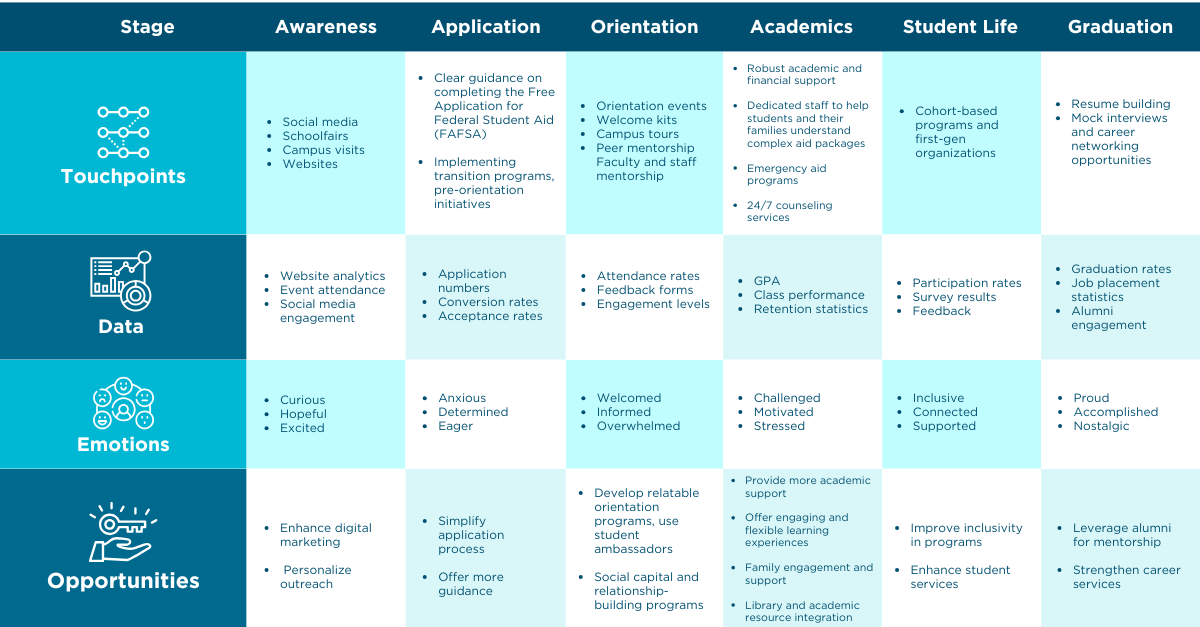Supporting First-Generation Students: A Guide for Higher Education Leaders
First-generation higher education students face a range of unique challenges in navigating the higher education system. As leaders in academic institutions, it is essential to acknowledge the multifaceted needs of this diverse student population and implement strategies that foster their success throughout the student life cycle. This article outlines effective strategies that institutions can implement to support first-generation students throughout their academic journey, from entry to graduation.
Building Social Capital for Academic Success
Social capital, characterized by relationships and networks that provide students with guidance and support, plays a critical role in enhancing the academic outcomes of first-generation students. Programs that facilitate networking and engagement with faculty and staff—highlighted in a study by Tobolowsky et al. (2020)—have been shown to significantly improve grade point averages and the likelihood of students seeking academic assistance. This is indicative of the importance of fostering connectivity and mentorship on campus.
Strategies should include:
1. Faculty mentorship programs where students are paired with faculty members who can guide them both academically and professionally.
2. Peer-led study groups that encourage collaboration and collective problem-solving among students.
3. Workshops and seminars that connect students with alumni and community leaders.

Coordinated Academic Support
Organized academic support services are vital for the perseverance and performance of first-generation students. According to López et al. (2023), integrating tutoring services with mentoring and robust orientation programs can lead to enhanced academic performance and persistence. Such approaches require a coordinated effort across departments to ensure students have access to necessary resources.
Key support strategies include:
1. Comprehensive orientation programs that introduce first-generation students to campus resources and academic expectations.
2. Tutoring centers offering personalized support in various subjects, with extended hours to accommodate differing schedules.
3. Early alert systems that identify struggling students and provide timely interventions.
Cultural Integration for a Sense of Belonging
Feeling a sense of belonging is crucial for the retention and success of first-generation students. Farrell-Felici and Panesar-Aguilar (2021) emphasize that cultural integration initiatives that align with communal goals help foster an inclusive environment. Still, caution is advised as poorly designed programs may hinder rather than help.
To enhance belonging:
1. Develop cultural competency training for faculty and staff to enhance their understanding of and support for diverse student backgrounds.
2. Create student organizations and events that celebrate cultural diversity and encourage student participation.
3. Initiate inclusive policies that embrace diverse cultural perspectives within the curriculum.
Aligning Institutional Policies
Institutional policies must reflect the needs of first-generation students to create a supportive environment. Tobolowsky et al. (2020) and Bassett (2020) suggest that policy alignment and professional development are crucial to maintaining support throughout a student's academic journey.
Recommended approaches include:
1. Regular reviews of institutional policies to ensure they address the barriers faced by first-generation students.
2. Investing in professional development programs that equip staff and faculty with strategies to support this group.
3. Establishing a cross-functional team dedicated to addressing the needs of first-generation students.
The Role of Family Engagement
Family support is an underutilized resource that can significantly impact the success of first-generation students. Institutions should consider strategies to engage families as partners in the educational process.
Suggestions include:
1. Family orientation sessions that educate families about the college experience and provide guidance on how they can offer support.
2. Providing resources and communication in multiple languages to accommodate diverse linguistic backgrounds.
3. Creating family-focused events that welcome families to campus and involve them in the academic community.

First-Generation Student Journey Map With Implementation Considerations

Conclusion
|
The journey of a first-generation student is a testament to resilience and ambition, a legacy in the making not just for themselves but for their families and communities. However, the data confirms that this journey is significantly more challenging than that of their continuing-generation peers. The disparities in retention, graduation rates, and long-term financial outcomes are not a reflection of a student's lack of potential but rather a clear indication of a systemic failure to meet their unique needs. Higher education leaders have a strategic and moral imperative to address this issue. Successfully supporting first-generation students requires a comprehensive and integrated approach that considers the social, academic, cultural, and family dimensions of their experiences. By implementing these research-based strategies, higher education leaders can create an environment that supports the success of first-generation students from entry through degree completion. It is through these collective efforts that institutions can not only support but also empower first-generation students to succeed. For more information on how we can help you, schedule a meeting with us or contact us at info@edutechloft.com. |




